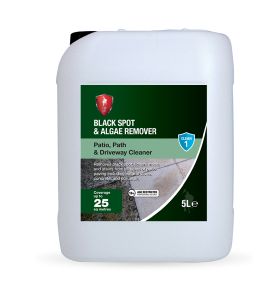
Patios have become really important areas, extending property footprints and allowing us to make the most of the great outdoors. For homeowners, these spaces have made periods of lockdown more bearable and, for many businesses, they’ve made trading more feasible in difficult times. Large or small, patios benefit greatly from periodic maintenance – and early autumn is an ideal time to get to work. It will cut down the ‘elbow grease’ required come springtime and will make outdoor spaces more pleasant over the winter months.
Time to tidy
Whilst most aluminium and wooden furniture can be left outdoors year-round, materials like wicker and rattan generally need to be protected – under covers or indoors. It’s a few weeks (hopefully) before we need to pack things away but it’s worth planning ahead now and clearing some storage space.
At this time of year, fallen petals and leaves quickly start to build up, especially behind pots and containers. If left in place, they’ll quickly decay, leaving stains and slippery deposits. It’s worth emptying and stacking pots before the temperatures drop – especially if they’re not frost-resistant. Surfaces can then be swept with ease and any weeds removed. The clearer the surface now, the less dirt will be picked up on footwear over the winter months.

The pre-winter clean
To properly remove stains and ingrained dirt, we recommend a thorough wash with LTP Grimex. A blast with a jet wash may seem like a quicker and easier option but it will only wash dirt off the surface. A specialist treatment will react with ingrained residue and organic matter, drawing it out of the stone’s porosity.
Before cleaning the patio, remove furniture, pots and other objects. Then, test your cleaning solution on an inconspicuous area.
How to apply LTP Grimex:
- To remove mild staining, dilute one part of Grimex with 10 parts of warm water. Wash the surface thoroughly, using a brush or yard broom, and rinse with clean water.
- For more severe staining, dilute one part of Grimex with 3 parts of warm water. Agitate with a scrubbing brush and leave to act for 5-10 minutes, adding more solution to keep the surface wet.
- Sweep up any residue and rinse thoroughly with clean water.
If your patio is prone to black spot, lichen, moss and algae, it’s worth targeting these now too. Periodic treatment with LTP Blackspot & Algae Remover will break down microspores and black spot ‘hyphae’ before they colonise. LTP Blackspot is acid-free, so it’s safe to use on acid-sensitive stone, but it does contain a bleaching action to remove stains. So, as before, test first on an inconspicuous area.

How to apply LTP Blackspot & Algae Remover:
- Remove furniture and other items from the area to be treated.
- Apply neat Blackspot onto clean pavers with a plastic watering can or light pressure garden spray.
- Leave to absorb for 2-4 hours; the product will begin to fizz as it gets to work.
- Hose off thoroughly with clean water.
Stopping water ingress
Once you’ve cleaned your pavers and they’re dry, it’s an ideal time to replace any lost jointing sand or cement mortar. This will stop the ingress of water and will help protect paving during the freeze and thaw cycle of winter.
Added protection
If your patio hasn’t been sealed, consider applying a protective treatment. We recommend LTP External Stone Sealer for natural stone and our new barrier treatment, LTP Porcelain Tile Protector for matt porcelain pavers. Both are non-film forming and will help prevent the absorption of moisture and organic particles, reducing staining and the spread of algae, mould and black spot.
LTP External Stone Sealer is a water-based, impregnating sealer that’s applied using a foam roller or paint brush, as shown in the Video Aid. It can be applied over residual moisture and will protect pavers from moisture, stains, weathering and efflorescence. It’s also UV resistant and non-yellowing.
LTP Porcelain Tile Protector creates a barrier against organic matter and makes ongoing maintenance easier. On newly laid tiles, it also protects against staining and helps increase working times. Our External Porcelain Tile guide includes lots of useful information on cleaning, protecting and caring for these surfaces.
To find out more, please visit http://www.ltp-online.co.uk. For further information, please contact LTP on tel. 01823 666213 or email [email protected]



